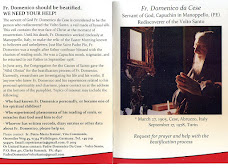by Paul Badde Rome, June 3, 2016 (CNA Deutsch)
(editor's note: this is a translation of an article by Paul Badde appearing at http://de.catholicnewsagency.com/story/exklusiv-paul-badde-uber-eine-spekaktulare-entdeckung-uber-die-grabtucher-christi-0842)
 |
| Theologian Klaus Berger |
The sudaria of Christ (today in Turin and Manoppello) had a key role in the Latin liturgy of the Roman rite of the Mass already 400 years before their first public display for veneration in Europe. Klaus Berger in Heidelberg has discovered and notified us about this sensational missing link in the history of the reception of the most important relics of Christendom which he found in a mysteriously incidental way during his research for an extensive commentary on the Apocalypse.
In the course of his research on the Apocalypse of St. John the New Testament scholar Klaus Berger of Heidelberg has made a sensational discovery. He found that in Amalarius (775-850) - head of the Carolingian liturgy, the Bishop of Metz, and Archbishop of Trier, who in 844 was made a cardinal by Pope Sergius II and is considered the forerunner of a united Latin liturgy of the Roman rite - the altar linens prescribed for the liturgy from the beginning were considered to be in direct correspondence with the cloths mentioned in the Gospels in relation to the Passion and Resurrection of Jesus Christ which in the Latin liturgical texts are called sindon or sudarium. Especially the deacon who wraps the chalice in a cloth as Jesus was wrapped in his cloth. Literally: Diaconus ... involvit cum sudarium calicem, quoniam Ioseph involvit in sindone munda. corporale... ipsum linteum quo totum corpus domini tegebatur in sepulchro. (The deacon wraps the chalice with the shroud. As Joseph of Arimathea wrapped the whole body of the Lord in a new burial cloth in the tomb).
And all this of course already in the Carolingian period, i.e., well over four centuries earlier than in Europe where the Sanctissimus Sudarium (Most Holy Sudarium) in 1208 was carried in public by Pope Innocent III for the first time from San Peter's in Rome, and well before the year 1355 when the Holy Shroud reappeared and was venerated for the first time in Lirey in the Champagne region! From this we can also understand why the altar linen, in analogy to the shroud, until 1969 had to be "pure linen," and why the so-called corporal must always be folded in a particular way by way of analogy with the Sudarium, of which John says that after Christ's resurrection was found by Peter and John in the empty tomb "not lying with the linen cloths but rolled up in a separate place." That corporal is the starched cloth which in the old rite, after the priest had come at the altar in contact with the bread and wine, could only be touched by him reverently with his thumb and forefinger.
Since the altar linens of the liturgy are called sindon and sudarium and theologically are in connection with the real presence of Jesus in his body and blood, it follows according to Klaus Berger this directed their "setting in life" [ "Sitz im Leben"] within the liturgy in regards to what is the scope of their purpose which is to point to the mystery of the Eucharist on the altar stone, where the inanimate matter of the bread and wine - as the tomb of Christ in the rock in Jerusalem, which had never been used - is always transformed into the "bread of life" and living blood of Christ.
The depiction of the face of Jesus on these cloths instead could be understood similarly to the so-called Mass of Pope Gregory: Gregory I (540-604) saw appearing to him a bloody Lord directly in connection with the transformation of the Eucharistic species. The shroud and the sudarium of Jesus would therefore be understood as the direct expression and personified the real presence of Jesus on the altar and would be directly related to the Eucharist as the center of the holy Mass. In this way they agree as biblically confirmed evidence of the resurrection of Christ with the mystery of the Eucharistic transformation. You could therefore say: Instead of the vision of Gregory, in Amalarius there is a real symbolic content of the altar cloths. In both cases it is an expression of the real presence of Christ. What is true for Pope Gregory the content of the vision, namely, the real bodily presence of Christ (particularly of the suffering Christ), according to Amalarius would be expressed sensibly ( "sinnenfällig") in the liturgical altar linens. On the burial cloths, showing the stigmata on the shroud and on the sudarium the face of Jesus, there appeared a lasting imprint of what happened for an instant in Gregory's vision.
In correspondence with this the cleanliness of these cloths would also point to the connection with the purity of the body and the heart of the concelebrants.







